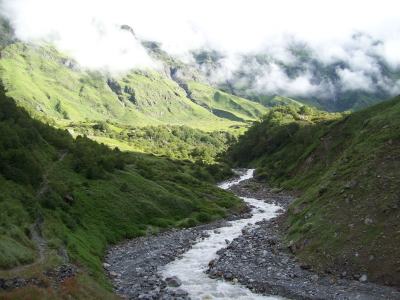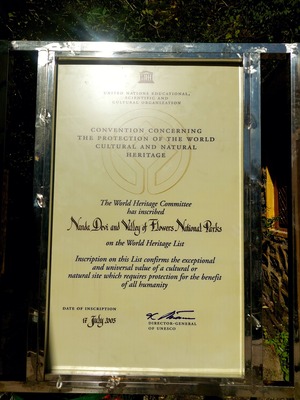Nanda Devi and Valley of Flowers

Nanda Devi and Valley of Flowers National Parks cover mountain landscapes in the West Himalayas that are renowned for their diverse alpine flora.
The Nanda Devi is India's second-highest mountain, and its park holds a spectacular landscape of glaciers, moraines, and alpine meadows. The nearby Valley of Flowers has diverse flora and is known for its medicinal plants and a huge variety of butterflies. Mammals encountered in both parks include tahr, snow leopard, musk deer, serow, Himalayan and black bear.
Community Perspective: Nanda Devi NP is closed to tourism (and mountaineering), while the Valley of Flowers does see a decent number of visitors. Go and watch the flowers in full bloom in July-August. Getting in requires a fair bit of hiking (though one stretch can be skipped by using a helicopter), as described by Zoë, though the Valley itself doesn't take much time to explore.
Map of Nanda Devi and Valley of Flowers
Community Reviews
Zoë Sheng
Chinese-Canadian - 20-Sep-24 -

Nanda Devi is closed. For tourists and mountaineers. You COULD go to the northern area as a scientist but it requires permits you won't get, and as you thus avoid the dangers (that's why it was closed) you are better off not going. You can't even see the peak from the Valley area. The Valley of Flowers is open and a majestic hike. It comes close to the "5 day to visit" and it could be seen as a tour-only visit but there are ways around it and you don't need a tour guide. It's better though - and not even expensive. I think overall I spent less than 100 dollars on all this.
To visit the Valley of Flowers you will first fly into Dehradun which is actually Jolly Grant airport that is closer to Rishikesh than the former. Your goal is Rishikesh, the birth of yoga, and there will be LOTS of Caucasian ladies on the flight (from Dheli mainly, although you can take a 6h bus from there and Dehradun is connected well with other cities). First I thought there are going to be lots of trekkers but they actually all come for the yoga. You will see a lot of yoga centers as you drive through the city. I can't say they are any good because honestly didn't try but in no way did people seem "fit" that I can recommend it or was there a "go to place". After Rishikesh there is no more meat allowed in the northern part of the country, no alcohol, no tobacco. I find the last two helpful but I personally feel that eating veg only doesn't add to the fitness levels. Many locals are thus vegetarians by no choice of their own.
Anyhow, your next destination is just north of Joshimath. If you have a tour they'll probably offer that you get driven there and have a hotel nearby. In my case I was NOT on a tour so a 550 rupee bus ride did the trick and you'll pay less for a hotel. At Govind Ghat you'll turn off east and change car. There is nothing you can do about that. My friend Geeta arranged this and it will just cost you a nominal fee to get up the hill east. 10 minutes later it is time to start hiking. Oh, wait! You can take a helicopter ride to Ghangaria for only 3,500 rupees which is like 40 USD. It's either that or hike up for 5 hours - UP! When you reach Ghangaria the old fashioned way you'll definitely sleep. Ok, so you can also take the horse/donkey up which costs half of the helicopter but I don't find that save. Some people on these were screaming and the guys owning them didn't seem to care much about the animals either. There is lots of poo to avoid on the way and the requests from cleaners to tip them. The small town also doesn't have much else but massages and tea.
Finally I can start talking about the Valley of Flowers but you haven't reached it quite yet. The entrance is just north of Ghangaria which requires a 3 hour hike up and this time you cannot take helicopters or donkeys - it's gonna have to be your own two feet. There is a rock sign that you have reached it but it's quite obvious when you have because the path will be flat, the valley will open and you can see Bhyundar Ganga in the distance (if no clouds). The tip looks like dragon scales so I'm very sure that a dragon once lived there and...ok no, you could say the same about the mountains near KL but once you see you'll remember my words.
The location is only open from mid-April to mid-October. The flowers are also only blooming for certain months of the year. Everything is marked well beforehand. Himalayan Blue Poppies were only available until end of August and in September when I visited there were all gone. Bummer. You can still see loooooots of flowers and the valley is beautiful. Because the last entry into the park is at noon and you have to exit before 4pm you basically want to start hiking in the morning, getting there at 10am and spend a few hours in the park. You aren't allowed to camp inside so this is this is the only way to see it.
When you get there you have the choice of staying near the entrance or walking down the path. The scenery won't change much. I spent around 1 hour walking along the path and aside from a creek crossing there wasn't much else to see. The big difference is that there are even less people now than you had at the beginning of the trail. You want to find a place just off the paths that is still allowed to be walked on (even taking a single plant or stepping on one is a sin, I mean, fine, not that anyway will really check). Once you reach such a spot just chill and enjoy it before heading back.
Aside from plants and the surrounding mountains there isn't much else to see. It's enough though, trust me. You'll be really happy you made it and it's one of those world heritage ticks that deserved the extra trek.
Question is when you want to go. The season is not very long and even September was very cold at night. Daytime wasn't a problem and I was fortunate not to have any rain. The better times are July and August but that's also monsoon time so expect some rain while you are on hiking.
FYI my second day was a tougher hike to Hemkunt lake and temple which is busier, allows the animals to go up, and is even sort of interested for a non-Sikh. I would say since you are already here you might as well go and check it out but that's up to you. Most people stay for 3 nights at the local "hotels" to see everything.
Hiranmay Ghosh
I visited the Valley of Flowers last week. While there were quite a bit of hardship on the route because of landslides, the valley provided an exhilarating experience. The flowers were in full-bloom and moist with rains. I could not see much of the mighty peaks due to clouds though!
Community Rating
Site Info
Site History
2005 Extended
To include Valley of Flowers National Park
1988 Inscribed
Site Links
Unesco Website
Official Website
Related
In the News
Connections
The site has 20 connections
Damaged
Ecology
Geography
History
Religion and Belief
Timeline
Trivia
Visiting conditions
WHS Names
WHS on Other Lists
World Heritage Process
Visitors
16 Community Members have visited.
The Plaque
 (photo by Paul S.)
(photo by Paul S.)